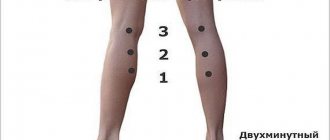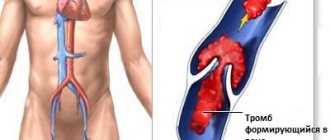Do you feel cramps in your legs? Do you wake up at night with sharp muscle pain? Let's look together at the main causes of seizures and answer frequently asked questions.
What are leg cramps?
A cramp is a sudden contraction of a muscle that does not relax for a variable period of time. Spasm, like pain, can be felt for both a long and short period of time. Muscle spasms arise from a large mass of accumulated decay products released when a vessel is compressed.
Causes of leg cramps at night
Each muscle cell is a carrier of an electrical discharge, since the inside of its walls are covered with potassium ions, and the outside with sodium ions. To prevent this ionic balance from being disturbed, cells have special pumps. Ionic charges allow cells to contract.
When a cell is influenced by nerve impulses, its charge becomes weak, as calcium and sodium ions penetrate inside, and potassium is excreted. When a cell contains calcium ions, it spasms. It is this condition that a person regards as a convulsion. To relieve a cramp, the cells launch special pumps that pump potassium into it and remove calcium and sodium.
In addition to electrolyte imbalance, seizures can be caused by neurological problems and disruptions in the circulatory system. Moreover, each of these reasons can lead to the development of seizures, both on their own and in combination with each other. It is necessary to dwell on them in more detail.
Water-electrolyte imbalance
If the balance between ions in cells and in the extracellular space is disturbed, then a person develops a seizure.
The following pathological reasons can provoke an imbalance of potassium, calcium, sodium, magnesium and chlorine ions:
- Dehydration of the body.
Electrolyte imbalance is most often caused by dehydration, in which the blood becomes thicker, the level of sodium in the blood decreases and muscle spasms develop. Also, convulsions will develop during massive blood loss, when the volume of circulating blood in the body sharply decreases.
- Taking diuretics.
If a person self-medicates or does not follow the doctor’s recommendations regarding taking diuretic medications, he may experience seizures. In this regard, it is especially dangerous not to comply with the dosage of loop diuretics, such as Furosemide, Lasix and carbonic anhydrase inhibitors (Diacarb). These drugs remove sodium and magnesium from the body, which contributes to the excitability of nerve endings and the development of muscle spasms. This problem is especially relevant for older people. They complain of cramps and muscle twitching that occur at night. Moreover, such convulsions can develop even simply by changing body position.
- Pregnancy.
While carrying a child, a woman’s body often experiences a deficiency of various vitamins and microelements. They are spent on the needs of the growing fetus. Therefore, pregnant women often experience leg cramps at night.
- Liver damage.
In cirrhosis, there is an imbalance between globulins and albumins. As a result, the patient may develop seizures.
- Chronic renal failure.
Patients forced to regularly undergo hemodialysis often experience leg cramps. (read more: Chronic renal failure)
Oxygen starvation of tissues
If body tissues experience oxygen starvation, this can provoke the accumulation of metabolic products in the body that have not undergone sufficient oxidation. Muscles exposed to hypoxia begin to contract, causing noticeable pain.
- Varicose veins
People suffering from varicose veins often experience leg cramps. In this case, the muscles spasm painfully at night if the load on the legs was high during the day, for example, the person walked a lot. In this regard, not only dynamic, but also static overvoltage of the veins is dangerous. In addition to cramps in the legs, the patient experiences swelling in them, and in the evenings he will experience heaviness in them. The legs are riddled with veins and small capillaries that swell and show through the skin. Varicose veins, and therefore cramps in the legs at night, often accompany people who work as hairdressers, teachers, and salespeople. Also, varicose veins often worsen in pregnant women.
- Damage to capillaries.
Small arteries are primarily affected in diabetics, smokers, and patients with intermittent claudication. The tissues of the lower extremities do not receive enough nutrition due to disturbances in the flow of arterial blood to them. In addition to cramps at night, such people are bothered by pain in the legs when walking, deterioration in the sensitivity of the limbs, and disruption of their thermoregulation.
- Flat feet.
Anomalies in the development of the foot lead to the fact that the load on the muscles and ligaments is distributed unevenly. This becomes the main cause of cramps in the lower extremities. With flat feet, both blood vessels and nerve endings are simultaneously affected.
- Raynaud's disease.
This disease is characterized by impaired capillary blood flow, which causes hypoxia of muscle tissue. As a result, a person often experiences cramps in the legs, the limbs freeze, and when in contact with cold they turn blue and spasm.
Nervous system diseases
Leg cramps at night can bother a person with diseases such as:
- Osteochondrosis of the spinal column.
- High body temperature that causes febrile seizures.
- Spastic paralysis can cause tonic cramps in the legs.
- Infectious diseases, for example, meningococcal infection.
- Poisoning from alcohol-containing products.
- Mushroom poisoning.
- Bites from poisonous insects and snakes.
- Injections of sea urchins and stingrays
- Vitamin D overdose.
Other reasons
A disease such as hypoparathyroidism can manifest itself as leg cramps. However, any damage to the parathyroid glands, accompanied by a decrease in their functions, will be expressed by muscle spasms.
In this case, convulsions will begin to affect the facial area and hands. The patient's hair falls out, weakness and fatigue increase, and other symptoms characteristic of hormonal disorders in the body develop.
Taking birth control pills can cause leg cramps in women.
Magnesium deficiency, calcium deficiency and B vitamin deficiency will lead to the development of leg cramps. With a lack of magnesium, a person suffers from insomnia, increased fatigue and irritability.
If a person is deficient in calcium, the condition of his hair and nails worsens.
With a deficiency of B vitamins, people, in addition to cramps, experience tingling in their toes, increased general weakness, and decreased performance.
Alcoholism is one of the reasons for the development of leg cramps at night. Regular and prolonged consumption of alcoholic beverages leads to the leaching of B vitamins from the body, which affects the condition of the muscles.
Prolonged stress can lead to the development of leg cramps, since during such periods the body spends a lot of magnesium and B vitamins.
Video: Dr. Evdokimenko about leg cramps, how to treat?
Causes of cramps at night
Our phlebologists note several sources that contribute to the occurrence of seizures:
The first source: disruption of normal blood flow in the lower extremities. This is explained by the fact that when blood stagnates in the vessels, the pressure in the veins begins to increase, fluid is released from the vein and spreads to the surrounding tissues. With the fluid, trace elements necessary for natural muscle contraction, such as sodium, calcium and potassium, are released from the blood. The reaction of this is a spontaneous and strong contraction with pain - this is how convulsions occur.
The second reason: the patient suffers from varicose veins. At night, blood flow in the veins slows down, and the body returns to its calm state. And with varicose veins, the process of slowing blood circulation slows down by half. In this regard, the muscles undergo impulse contractions, trying to help the heart push blood through the veins.
The third reason: the ATP mechanism fails. So that at the moment of contraction the muscle can assume a calm state, it is supposed to relax. The body has an element responsible for this action - ATP molecules. If the blood stagnates, the production of ATP is significantly reduced. This means that the ATP mechanism fails.
Why do seizures occur in healthy people?
Sometimes leg cramps at night can occur in completely healthy people. Most often they are triggered by excessive muscle tension. Due to their professional duties, people spend a long time in one position. At night, when the muscles relax, they begin to cramp.
For example, circus performers and ballerinas suffer from leg cramps more often than other people. The same applies to professional athletes and track and field athletes, skiers and speed skaters. Thus, the characteristics of professional activity can cause the development of leg cramps at night, even if the person does not suffer from any diseases.
Nighttime muscle spasms in the lower extremities can bother vegetarians. This is especially true when a person strictly limits proteins and foods containing calcium and magnesium in his diet.
Surprisingly, people who drink green tea can suffer from leg cramps. If you drink it for many years, very often and in large quantities, this will lead to leaching of beneficial microelements from the body. The fact is that this drink has a diuretic effect, which many people are not even aware of.
How to treat leg cramps at night?
Leg cramps never occur on their own. To prevent their development, it is necessary to influence the cause that led to the occurrence of a convulsive attack.
Activities may be as follows:
- To prevent dehydration, you need to drink enough water. This is very important for proper muscle function. This rule is especially relevant for the hot season, as well as for people involved in active sports. It is best to give preference to mineral water, rich in beneficial microelements.
- If you lose fluid during vomiting or diarrhea, you need to drink enough water. Experts advise taking rehydration solutions (Regidron, Gidrovit, etc.). If after a few hours the situation does not improve, then you should seek medical help.
- To prevent seizures from taking medications, you must strictly follow your doctor’s recommendations. If, despite this, muscle spasms continue to haunt a person, then the question of reviewing therapy needs to be raised.
- To avoid leg cramps during pregnancy, a woman needs to take vitamin and mineral complexes.
- Patients with liver cirrhosis should receive adequate treatment for the disease, take hepatoprotectors, follow a diet, and stop drinking alcohol. When fluid accumulates in the abdominal cavity, it needs to be pumped out.
- If the cause of leg cramps lies in varicose veins, then you need to follow a diet aimed at reducing excess weight. You should definitely stop smoking. When varicose veins have just begun to develop, wearing compression garments can help. Cramps may stop bothering you when a person begins to receive treatment with venotonics in creams and ointments (Troxevasin, Venitan, etc.), as well as in tablets (Eskuzan, Detralex, Phlebodia 600, etc.). If conservative treatment does not help cope with the existing problem, then surgery is necessary.
- Patients with diabetes should make every effort to keep their glucose levels under control. This will stop the progression of the disease and prevent serious complications from developing. At the initial stage of diabetes, you can try to adjust your menu, adhere to a strict diet and increase physical activity. If this does not help, then treatment is supplemented with sugar-burning drugs and/or insulin injections.
- To relieve spasm from blood vessels, which causes leg cramps during obliterating endarteritis, it is necessary to take antispasmodics, for example, Drotaverine. Antibiotics and corticosteroids are prescribed to reduce inflammation in the veins. The patient should receive vitamins and anticoagulants. If a patient develops ulcers on his legs, then surgical intervention is necessary to reconstruct the veins or improve the functioning of the blood vessels.
- If leg cramps develop due to flat feet, then treatment should be started as early as possible. Conservative therapy is effective only at the first stage of the disease. If a person is overweight, he needs to lose weight, follow a diet, and reduce the load on the foot. At the next stages of development of the pathology, surgery is indicated for the patient.
- Vitamin D must be given to the child in strict accordance with the dosage prescribed by the doctor.
- To prevent the development of leg cramps at night with Raynaud's syndrome, the limbs must be kept warm. It is possible to take drugs such as Nifedipine, Verapamil, Captopril, Ketanserin. In parallel, therapy is carried out for the underlying disease, which provoked the development of Raynaud's syndrome. Physiotherapeutic procedures, reflexology, hyperbaric oxygenation, etc. have proven themselves well.
- To prevent seizures with hyperparathyroidism, a person should be regularly examined by an endocrinologist. His menu should include foods such as vegetables, fruits, and dairy drinks. They are rich in calcium and magnesium, but deprived of phosphorus, which is important for such patients. In parallel, calcium supplements with ammonium chloride and vitamin D supplements are prescribed.
- If a child is prone to febrile convulsions, then it is necessary to give him antipyretic drugs in a timely manner, preventing the body temperature from rising to high levels.
- It is imperative to take magnesium with vitamin B6 if seizures are caused by a deficiency of this microelement. As a rule, the full course of treatment should be about 8 weeks. After this time, cramps will stop bothering the person. Drugs for treatment: Magnistad, Magnelis B6, etc. At the same time, you need to eat foods rich in magnesium: parsley, onions, dill, dried apricots, prunes, bran, beans, legumes, seaweed.
- If seizures develop due to a deficiency of B vitamins, then a course of injections with the drug Milgamma should be performed. You need to start with 5 injections, give them every other day. If you feel better, then you need to give 5 more injections.
- If there is a deficiency of calcium in the body, it is necessary to take it in tablets. You can choose a combined form of medication, where calcium is combined with vitamin D. This way it is better absorbed. The course of treatment is 30 days. At the same time, you need to enrich your menu with foods with calcium: cottage cheese, cheese, sesame seeds, fermented milk drinks, broccoli.
- To relax muscles, muscle relaxants can be used, such as: Mydocalm, Tolperisone, Sirdalud, Baclofen.
Maintaining a healthy lifestyle, quitting smoking and drinking alcohol is an excellent prevention of leg cramps.
[Video] Dr. Berg - LEG CRAMPS. Legs cramp at night: what to do?
The causes of seizures can be different:
- disturbance of the biochemical and/or electrolyte composition of the blood;
- physical exercise,
- uncomfortable shoes.
Night cramps often indicate the presence of venous disease. When the veins dilate, blood stagnates, which reduces the delivery of oxygen to tissues and stops the production of ATP, a universal source of energy in the body necessary for normal muscle function. The frequency of seizures also indicates the presence of varicose veins. If your legs begin to cramp more often, this indicates an increase in venous stagnation and tissue swelling.
How to quickly get rid of cramps after waking up?
There are simple tips that can help quickly stop leg cramps and restore their sensitivity:
- A cramp that causes a person to wake up can be eliminated by stretching the leg and foot. To do this, you need to get out of bed and walk a little on your toes.
- If you don’t want to get out of bed, you can simply straighten your foot while lying down.
- You can also massage the problem area of your leg right in bed, gently stroking and kneading it.
- The spasm can be stopped by pricking the skin of the leg with something sharp, for example, a pencil.
- You can apply a warming ointment to the skin of the lower limb or rub it with alcohol.
- Sometimes just moving your leg is enough for the brain to receive a signal that everything is fine with the body.
By following these recommendations, you can not only stop the cramp, but also prevent its reoccurrence.
Video: 3 ways to relieve cramps:
Leg cramps due to varicose veins, what can be done about it
Only treatment of the latter can completely eliminate leg cramps due to varicose veins. Elimination of venous reflux and, as a consequence, venous stasis makes it possible to restore metabolic disorders in the tissues of the lower extremities.
Today, a large number of doctors treat varicose veins. These are general and vascular surgeons and even some therapists. But only a specialized specialist, a phlebologist, can provide truly effective assistance. The doctor must be fluent in ultrasound diagnostic techniques and manipulation techniques under ultrasound navigation. These skills are essential for modern treatment of varicose veins. Only contacting an experienced phlebologist will allow you to get rid of the symptom of leg cramps once and for all.
Exercises to prevent seizures
To avoid leg cramps at night, you need to do the following exercises before going to bed:
- Stand on your heels and stand there for 20 seconds.
- Spread your heels apart and point your toes together. Stay like this for another 20 seconds.
- Place your heels together and point your toes in different directions. Stand in this position for 20 minutes.
- Sit on a chair and quickly bend and straighten your toes.
- Stand up and walk on the outside and inside of your feet.
- Sit on a chair and try to write numbers from one to ten in the air with your feet.
- Sit on the floor, bend your knees and pull your toes towards you. During the exercise, you need to feel how the calf muscle stretches. You need to perform the exercise 3 times for 10 seconds each.
- Stand on your toes, stretch your arms up, and lower yourself onto your heels. Perform the exercise 5 times for 10 seconds.
- Stand up, tilt your torso forward, touch your toes, but keep your heels pressed to the floor. Repeat the exercise 6 times for 10 seconds.










